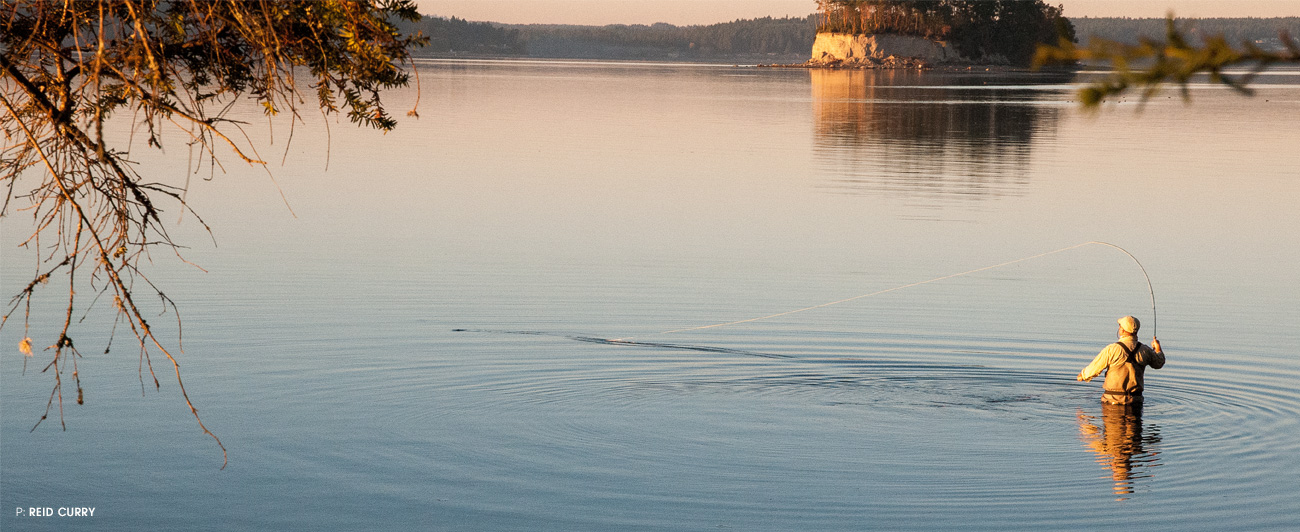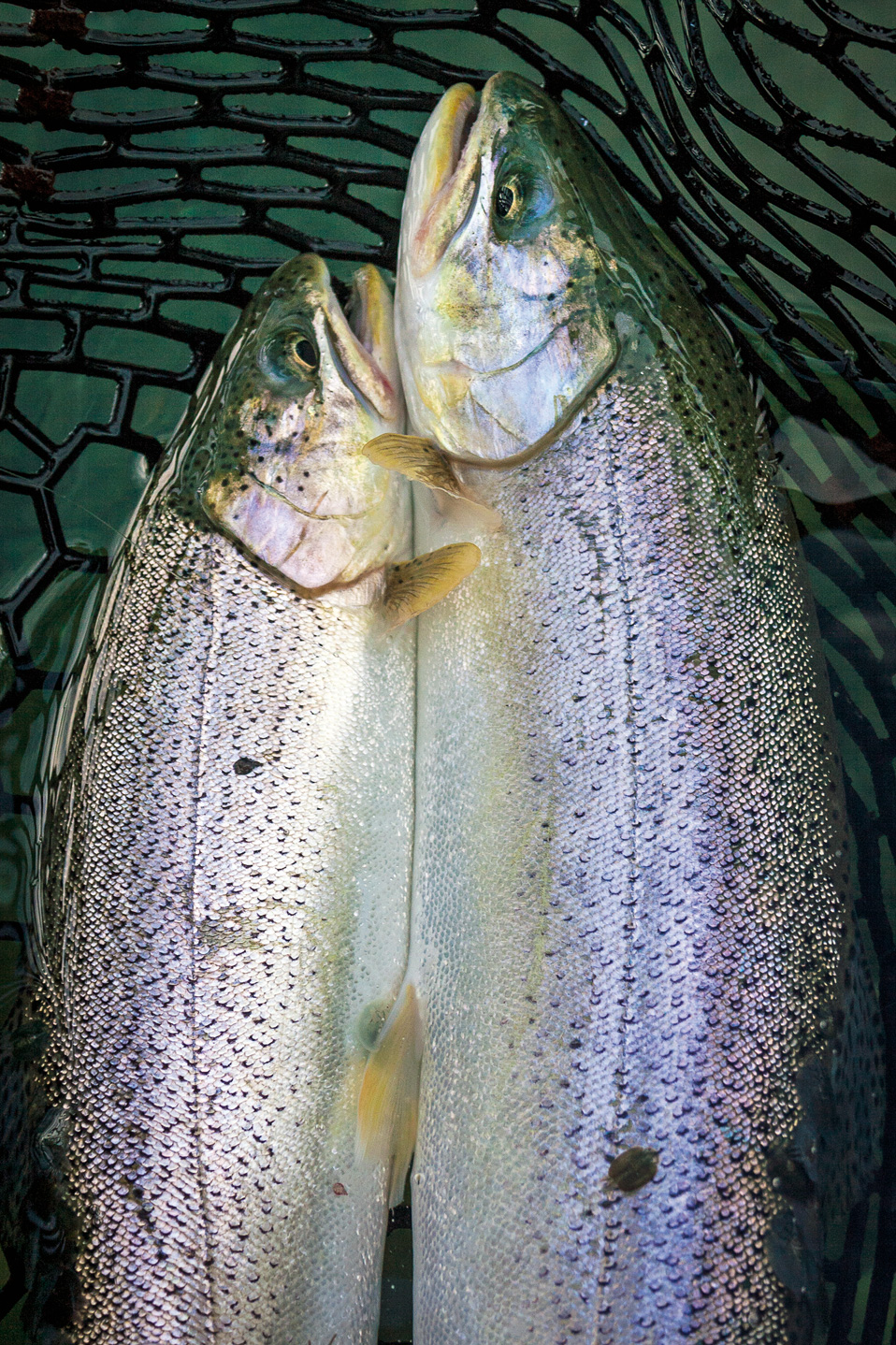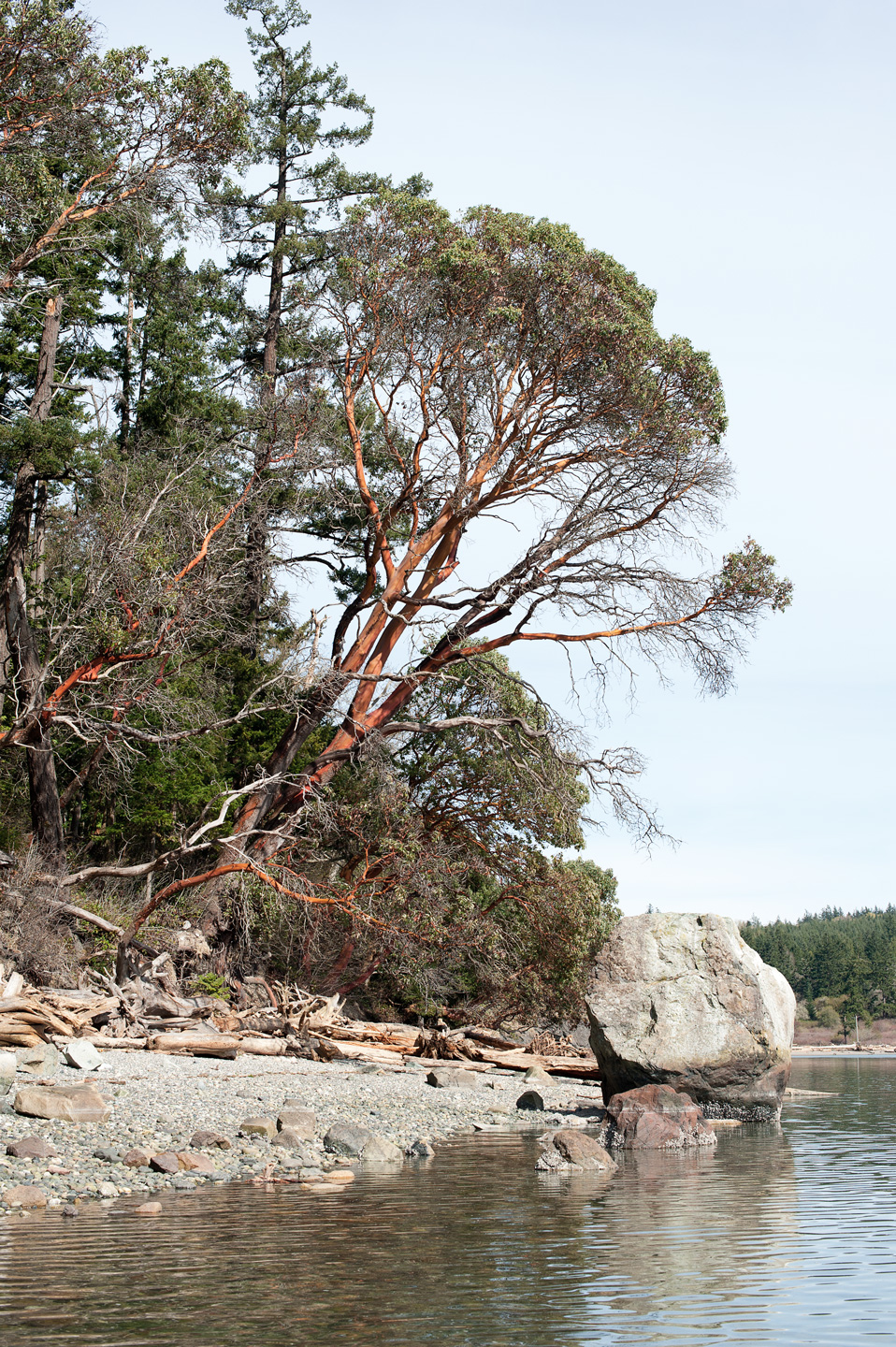Fiction
On Account of Opening Day
above Puget Sound has many faces. Sometimes it’s white-capped and violent, other days so calm even the faintest ripple expands in endless, perfect rings. Rick Groman enjoys the quiet embrace of a breathless evening and feeding sea-run cutthroat on a beach near Seattle. Photo: Reid Curry
The great joy of spring thaws to one fundamental idea—that you made it to another one. We’ve already had April days that remind us of how good we have it, bright and still with everything cut just perfect. The rhodies bloom, the ospreys return, the rain finally lets up and those last big dumps of March snow on the Olympics are illuminated by harsh, spectacular sun.
Most days these past few weeks have been good to be on the water, so I took some time and drove to a favorite beach. It’s a place where currents meet on a small peninsula on Colvos Passage. You can paddle there, true, but I prefer to walk through forest and fern, down a half-mile bluff path to a beach I’d like to think only I know about. Soon enough, I’m alone, knee-deep in salt-water, fishing for sea-run cutthroat trout.
Where I stand the currents buckle into wavelets. The water is otherwise flat. Two kids on paddleboards come into view, moving toward this small peninsula. I hear the dip and small splash of their strokes. They are heading for a beach of fist-sized rocks that merges to sand about 50 yards from me. The boy holds his hand out to the girl, who steps off after him. The girl waves and I wave back.
The kids are probably 16 years old, they shouldn’t be out, at least not dressed like that. They’re thin and sleek and if they fell in they’d be in trouble. That water’s cold all year. I can’t help that this keeps bugging me; they are underdressed, underprepared and unaware. Not a life jacket between them.
Part of that irritation is because the boy resembles my nephew, John P. Rollow. I know it’s not him—John’s in Arizona now with his mom, and this kid’s about two feet taller than John. It’s the board shorts, a bold pattern of Hawaiian flowers, like John used to wear. The girl’s in a scoop-back one-piece, thin hips, strong shoulders, slight stoop to her posture, the kind of swimmer’s build that suggests she could race butterfly or long-haul medley. They both look fit, young and perfect. And yet, they are underprepared and unaware.
I’m watching them because the small loop knot I’m tying won’t cinch. My hands shake a little and the leader and hook eye go blurry. It might as well be invisible. I try, fail, curse, pause, look up, let my eyes focus a little, try again, and for another break I stare at the kids.
They’re lying down now, the boy’s head rests on his hand, elbow propped in the sand, bright sun on both of them. He’s found a big Dungeness crab claw; it’s dried and bleached. He tries to move the jaws, but they’re locked. He brushes sand from it and moves the claw toward the skin of her back. He touches her with the claw tip, writing on her. I suppose the claw leaves a faint line on her skin.
In that moment, I see her smile. She touches his shoulder then takes the claw from him and moves it faster toward him, under his arm, tickles him, which causes him to buckle, to collapse laughing, and from this distance, those sounds merge into a pair of buffleheads fluttering and taking flight close by, spooked by something deeper, darker and underwater. I look away, trace the birds, watch that final moment when some part of them no longer touches the water and moves entirely into the air. It’s one of those April moments in which everything is magnified and spectacular.
Except this goddamn knot. I still can’t thread the eye, so I look back at the kids.
The boy reaches forward, excavating into the beach, scoops out what looks like a big stone. He brushes his find and when he does, I can see stitches—it’s a ball, a baseball—not a crisp new one, but weathered up after a winter outside. Light brown, half-dirty, half-sun-bleached, mottled, waterlogged inside. It probably weighs more than it should.
He rolls onto his back, throws it lightly straight up into the air, catches it, throws again.
I look away, trace the birds, watch that final moment when some part of them no longer touches the water and moves entirely into the air. It’s one of those April moments in which everything is magnified and spectacular.
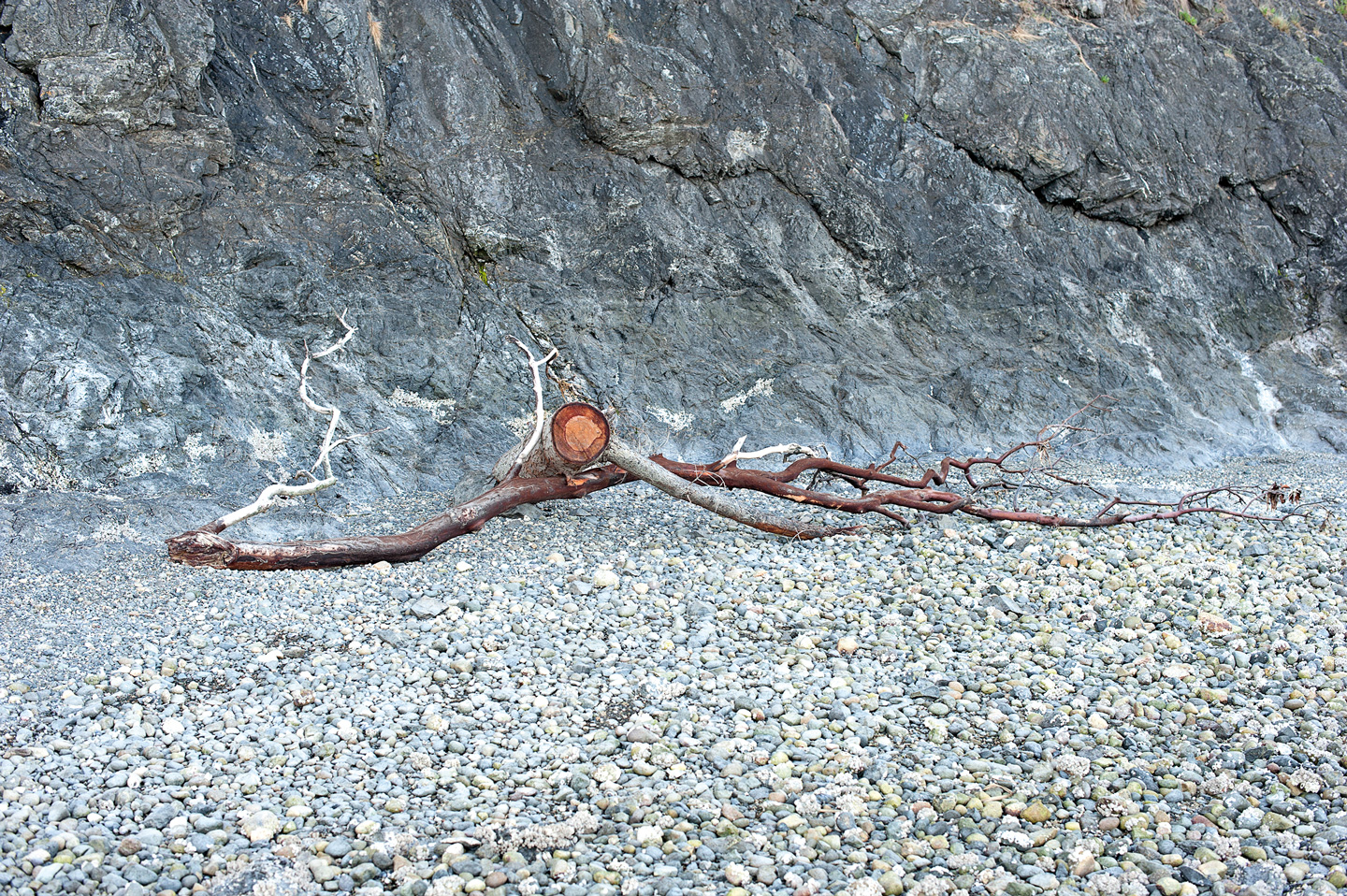
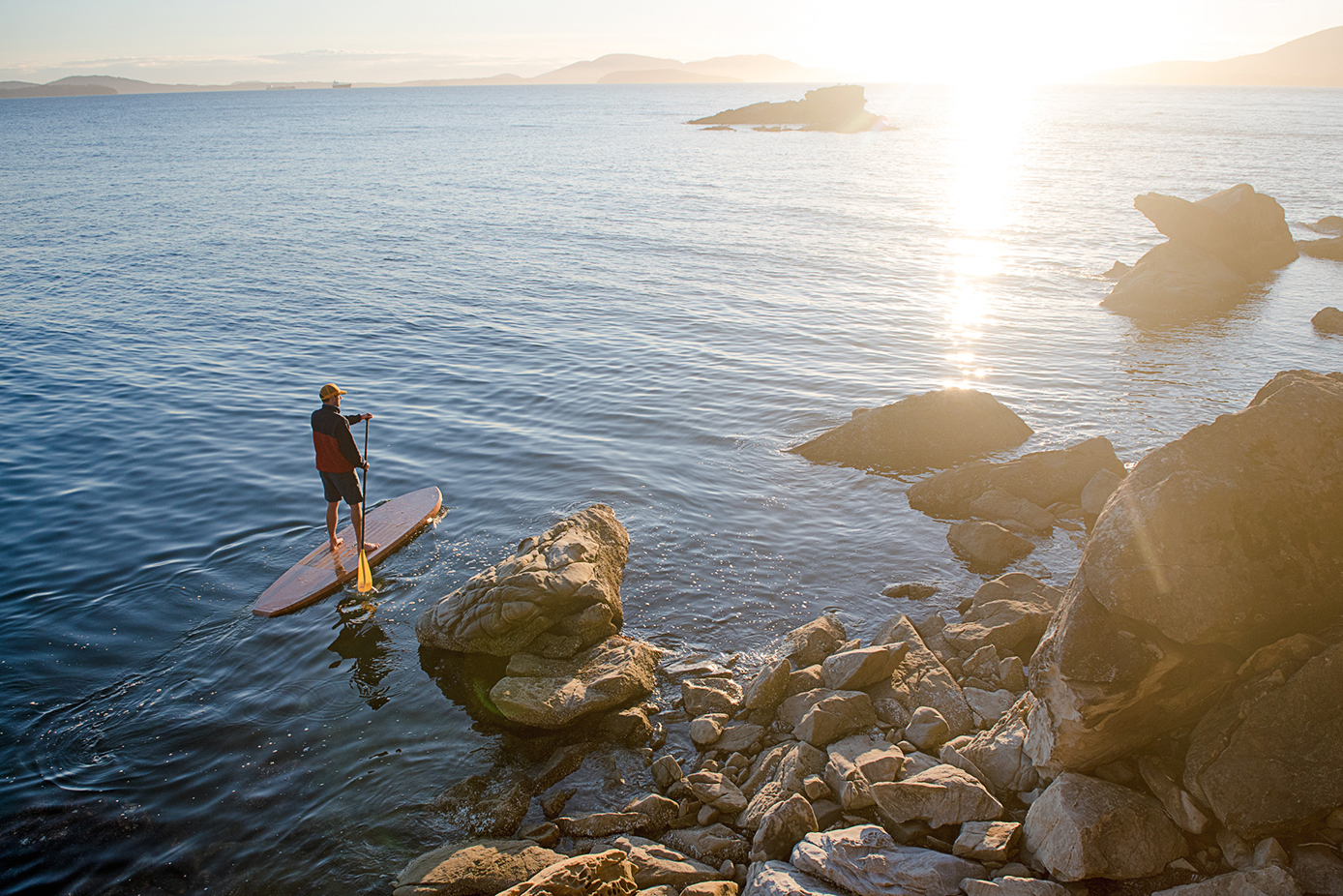
above top to bottom “Because of my curiosity about the surrounding landscapes and my utter deficiency in hunting anadromous fish from the beach, I often end up simply taking my fly rod for a walk. This day, low tide revealed an interesting tangle of madrone splayed against a cliff on a Puget Sound beach.” Photo: Copi Vojta
Leif Whittaker patrols the coastline just south of Bellingham, WA, on an after-work paddle.Photo: Freya Fennwood
The knot finally draws as it should and I’m back to fishing the point. I wade out a pace or two. I can feel how reassuringly cool the water is through the skin of the waders. Fifty degrees, perhaps less. Too cold to swim, too cold to be dressed like those kids.
Tiny schools of salmon fry are moving by my feet, slipping as close to where water meets shore as they can get. But at the point—and between my boots—these young fish spook, they confuse in the swirling current, they try and steal past me, they balk, they make mistakes and they’re vulnerable. The bigger fish will pick them off in the deeper water.
A chum baby is on the end my line. It mimics those tiny fish. It’s a brown spark of fly, flocked with tinsel and camouflaged with some strands of squirrel tail. I’m throwing line, pushing it out as far as I can, mending it a little, letting it sink, stripping it in. There should be a familiar smack in the line, a pull, a strike. The sea-run cutts should be here. No swirls, no boils, no scampering of bait spooked from below, no flashes of fish rising. Just these tiny vulnerable fry swimming by.
In the monotony of casting, retrieving, adjusting and trying again, my thoughts wander to that baseball the kid found in the sand, and from there, to April two years ago. That ball thrown up and down caught in the kid’s hand and those goofy board shorts brought me back to thinking of John P. Rollow, my nephew. Me and him and a bucket of balls in the backyard. We were practicing pitching.
I would catch for John P. Rollow, and if you’ve ever knelt with your back to your garage and had a kid throw an hour’s worth of baseballs at you when you’re 45 years old and they’re 12, you know pain. It’s calf pain, which by pitch number 10 migrates to the knees, then to the lower back and thighs, and then I start to lose track because it’s everywhere and I start shaking some, at least until I get a chance to pick myself up for a moment, tilt the catcher’s mask back and gather the balls I missed because I’m sorta blind and not much of a catcher anyway. I fail to catch about half of John P. Rollow’s unambiguous fat strikes. I stand up and stretch for a minute while John P. Rollow’s still staring me down. He’s trying to get a look that he thinks—at age 12 and in neon-green hibiscus board shorts—intimidates, even though he breaks his gaze off too soon and appears to have a regressive habit of chewing his mitt, in particular a loose and presumably disgusting—though sorta salty—strip of leather.
I can’t help but stifle a chuckle. He’s just a kid all fresh with possibility. He loves pitching, it’s his constant, his pole star. So I take a minute from the not-so-wild pitches and the scavenging among the burrs and barbs as I gather balls the kid should be getting. I don’t have the heart to make him do it though. He’s lost something far worse than a couple of errant balls. His dad, his old man, my brother-in-law.
There should be a familiar smack in the line, a pull, a strike. The sea-run cutts should be here. No swirls, no boils, no scampering of bait spooked from below, no flashes of fish rising. Just these tiny vulnerable fry swimming by.
above Two chunky sea-run cutthroat from southern Puget Sound stop by for a quick dental exam. Double ups are common when conditions are right, and these aggressive trout have the salt in their blood.Photo: Dylan Rose
It’s Neil Rollow that should be digging the balls out from the rotting leaves of last fall and tossing them in this bucket, not me. Neil should be behind the catcher’s mask, blinking and involuntarily wincing when the ball’s about to smack into it. Neil should be stretching out tight muscles and pushing himself slowly up from a graceless position. Neil should be shouting, “If you want to terrify a batter, don’t suck your mitt. It’s not a blanket.”
But Neil’s gone. Nothing’s going to change that.
I walk out there with a bucket of balls and those stupid thoughts combined with calf and ass pain and an expression on my face that is supposed to somehow make it look like I am having the time of my life. I’m not fishing for cutts on Colvos Passage on this perfect April day, I am struggling to fill Neil’s place for a child still grieving—a kid who loves to pitch. I’m not a father and I sure ain’t a dad, but I’m willing to show up and be there for him because, well, who wouldn’t?
In my child-free mind, the apex thought I can come up with to teach a 12 year old what he needs to know in life this perfect Saturday isn’t how to talk to girls, or how to show up on time, or ways to learn, or why don’t we go fish Colvos, it comes down to one ridiculous lesson. I decide to show the kid the pitch—the stupid, exotic, fascinating pitch called a knuckleball.
I start to explain the knuckleball—the fingertip grip. I make John P. Rollow spread his small-man fingers, balance that baseball on the end of his 12-year-old hand, demonstrate the push, throw a few knuckleballs of my own that make a kind of satisfactory smack and leave a small ding on the cedar siding that surrounds the garage.
Meaning that the pitch I threw, my half-assed knuckleball, was so abysmal and inaccurate and uninspired that I missed a garage door from 40 feet away, and even in the most generous game of backyard ball I’d be given the stink eye or someone would bitch and moan or beg someone else to pitch. Someone might even say, “Pitch it underhand.”
In one sense, I set a poor example—I didn’t throw a ball, I launched a wild pitch. Undeterred, I go on to throw another equally poor ball and add, “It’s enthusiasm—enthusiasm carries the day. Confidence.”
I nod a few times so he knows I’m serious. And my nod is an uncle’s nod, worthy of skepticism, and John P. is smiling because he knows I’m a little bit full of shit, but he also knows it is enthusiasm that carries the day.
I go on, I’m rolling now. “If mastered, the knuckleball promises a pitcher longevity and the kind of paycheck that—for a Major League ballplayer—may not be that much up front, but with the decades that your shoulder can continue to throw it, pays off in the long run. It’s baseball’s version of the tortoise and the hare.”
I introduce John P. Rollow to an understanding of a specific tool—an excellent and rare pitch he can develop with 10,000 hours practice. “In that time,” I tell him, “you will come to know that the delaying of gratification and mastery of a rare skill are the cardinal principles of long-term income generation.”
I give this ridiculous and sort-of-essential lecture to a 12 year old in the space of five minutes. Meanwhile the knot in my leg is working its way out, the marks on my face from the catcher’s mask redden and raise a little. My head resembles a weird basketball that won’t stop talking. It’s not a flattering picture.
Although I believe in the merits of delaying gratification and the need to become excellent at something—anything, really—it’s the specifics of throwing a knuckleball that I know very little about. I know very little about it, but I’m confident and I’m joking around and I’m half-serious and half-not, half-bleached, half-weathered, red lines on my face merging with my wrinkles. I’m not a dad, but now that Neil’s gone, what am I to this boy? Am I still just an uncle?
In my child-free mind, the apex thought I can come up with to teach a 12 year old what he needs to know in life this perfect Saturday isn’t how to talk to girls, or how to show up on time, or ways to learn, or why don’t we go fish Colvos, it comes down to one ridiculous lesson. I decide to show the kid the pitch—stupid, exotic, fascinating pitch called a knuckleball.
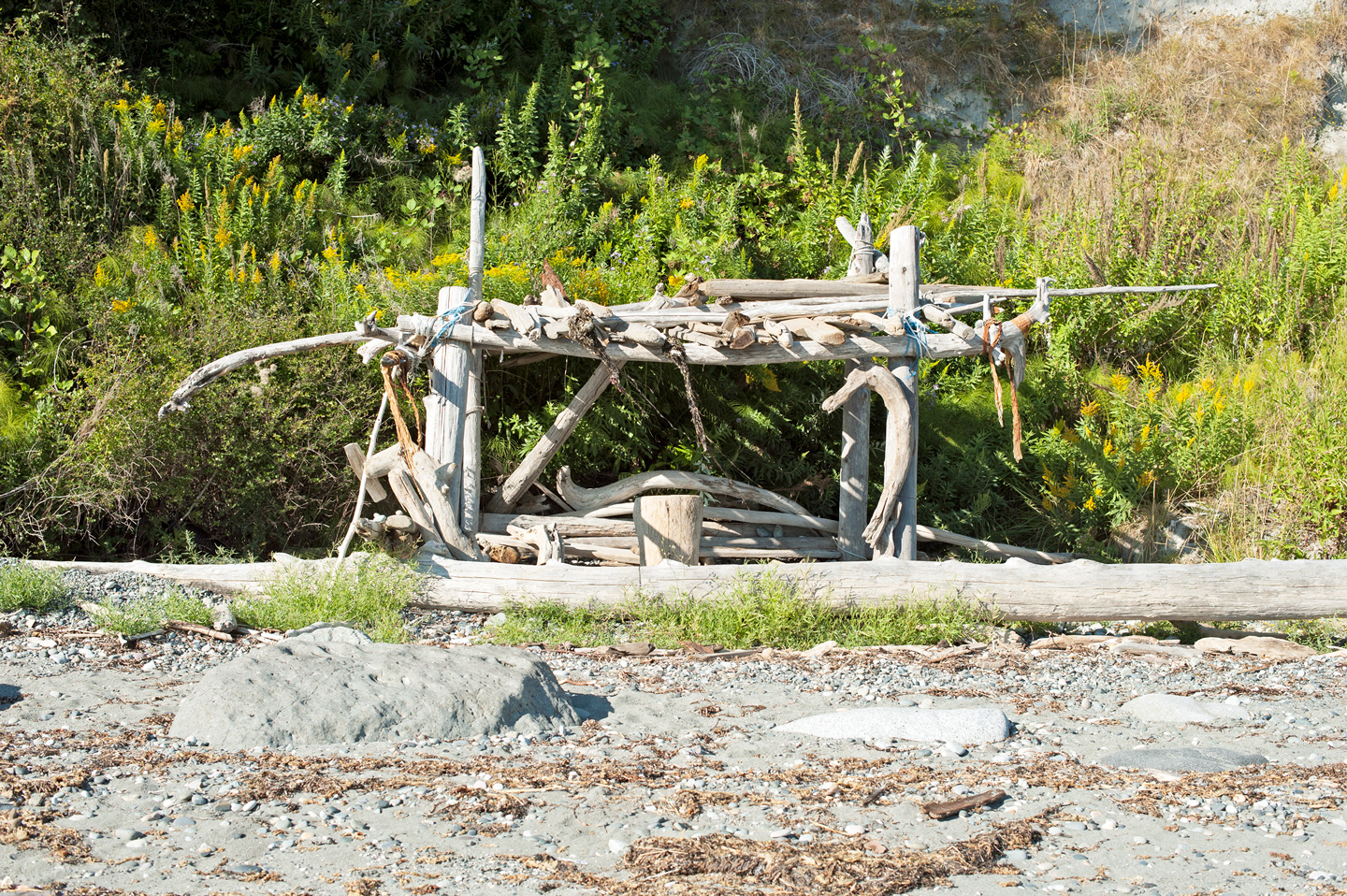
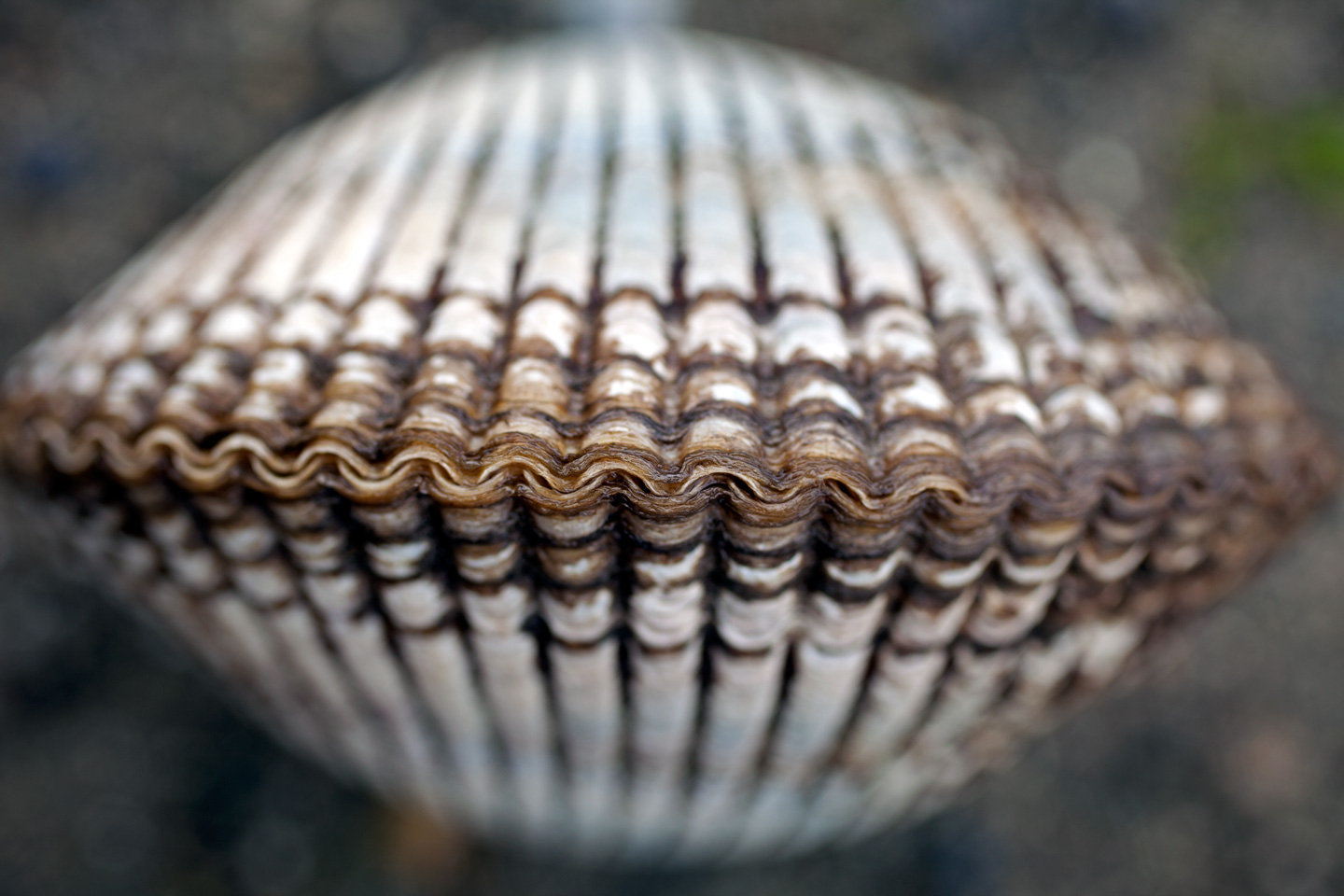
above top to bottom Beachfront property. A well-made driftwood fort is a common sight when exploring the beaches of Puget Sound. Bonus: No landscaping required. Photo: Copi Vojta
“Strolling down the beach, half watching the water and half trying not to trip over driftwood and seaweed, I came across this bivalve resting in the sand awaiting the next high tide. Unfortunately, I did not have my shucking knife.”
Photo: Dave McCoy
John P. Rollow, just coming into the angles that will later define his adult face, spattered in cutthroat freckles like his dad, is back to looking at me blankly, neither bored nor interested, just sort of neutral—in a way that suggests appropriate skepticism that a knuckleball is a fantastic pitch. This kid just lost any belief in magic anyway, buried it with his old man a month ago. I’m trying to kindle some of it back, and at the very least, at the most fundamental level, I’m there to show John P. Rollow he is not alone—that he made it to another glorious April even if his dad didn’t.
That flat affect meant he was taking it all in. Wisdom—straight, generous male wisdom. Men’s business. Aboriginal stuff. Oral histories of Tim Wakefield, Phil Niekro and Old Sarge himself—Hoyt Wilhelm—king of the knuckleballers. You don’t need to be a dad to know this stuff. I tell him, “Fact is, Neil meant to tell you about this pitch, and frankly, it was only to be shared when you were much older than you are now, but your old man told me this, he told me you have the grace and gift to be a world-class knuckleballer.”
I tell him all this with my arm on his shoulder, so it comes delivered in words and touch, like I’ve channeled his dad. Men’s business that was his right and need to know. And the kid still stares at me blankly and then looks down because, well, I’m in a place he’s not familiar with.
I mentioned his dad, by name.
I can see John is sniffing, his big, beautiful eyes are watering and if I say more, he’s going to lose it and the moment when he throws ball after ball will be lost. He will ghost away. Although that might take care of the pains of crouching, this ain’t about me. So I back off, tilt the catcher’s mask over my face and say, “Let’s throw,” and I squeeze his shoulder, walk back to where I crouched before, slink down and soon the pain starts again. Mine and his this time.
With the next bucket of balls brought back to John P. Rollow, who did try to throw some knuckleballs—unsuccessfully—I launch into the merits of the pitch. “You finesse a batter with a ball that fails to rotate, because a ball that doesn’t rotate is unpredictable.”
I use the analogy of a rifled barrel, a football’s spiral, a Frisbee thrown hard. You get spin, you get straight and predictable. “But with a knuckleball, you have no spin. And it’s the absence of spin, and at a certain velocity, there’ll be a whole different performance to the stuff you throw. The ball’s stitches, traveling at 70 mph will buckle the air around them and shimmy it—it flutters like a butterfly, it dances, it becomes magical.”
“Thrown 20 mph slower, you don’t fatigue your arm, you don’t wear your shoulder joint into a sclerotic little cleat, you don’t tear your labrum. You will pitch forever. Till you’re 45 if need be, or 50, like Old Sarge Hoyt Wilhelm, the first pitcher to ever throw 1,000 games of Major League ball. Old Sarge Hoyt throwing knuckles with a chunk of shrapnel in his back on account of some goddamn Nazi assholes who tried to kill him at the Battle of the Bulge back in the Big Deuce.
Longevity. Perseverance. Some constant nagging motivation and/or suffering. Those are the paths you walk to get to the Hall of Fame. You know what I’m saying here, John?”
Then all solemn and serious I tell him one of my regrets was that I never mastered the knuckleball. And he jokes that he knows, he can see that, and we both laugh, and there are no more big, watery eyes.
I touch John P. Rollow’s tiny bicep, that strip of tricep, that bubble of deltoid, that curve of brachialis, and wonder, what about this boy, what about this 12 year old, what about this unmolded clay makes me believe this left-handed string bean will be the one who absorbs a lecture on delayed gratification and knuckleballing. What makes me think this kid can take a chunk of emotional shrapnel and turn it into something great?
It’s because the kid just plain loves throwing. It’s because at age 12 and maybe for just one more year, a boy like John P. Rollow still seriously believes he might be a Major League pitcher someday, and there’s something so gentle and spectacular about that.
You will pitch forever. Till you’re 45 if need be, or 50, like Old Sarge Hoyt Wilhelm, the first pitcher to ever throw 1,000 games of Major League ball. Old Sarge Hoyt throwing knuckles with a chunk of shrapnel in his back on account of some goddamn Nazi assholes who tried to kill him at the Battle of the Bulge back in the Big Deuce.
above Madrone trees are unique to the Pacific Northwest. Their smooth reddish skin and towering, skeletal appearance strike an unmistakable presence along the Washington state coastline. Photo: Copi Vojta
The kids on the beach are setting off, paddling over the eelgrass and submerged boulders beneath the bluffs. If you could see what they could, you’d note small debris moving with the tide, tiny crustaceans that float and buzz and flip, small balloons of fish, more chum fry, all heading north, toward me and up-passage and into Puget Sound and finally the Pacific. The Major League.
In their grace the kids move from standing to sitting. She carefully ends up crisscross on her board, goofs a yoga pose and laughs. And he makes his way onto his belly, scooches all the way to the end, hands cupped over face, blocking glare, looking down into the water. They are perfectly balanced in the way only a kid or a real catcher can keep that confidently still. He sees sea stars, tiny ghostly spider crabs and the deep shadow of their boards. Everywhere he looks is change, movement, life, currents that shift with densities. And there is death and destruction, the crab tearing at the fish carcass, the pile perch snapping at small shrimp, the vast slow-to-rot mitt-brown and red leather-barked madrone fallen in a bluff-slide from this last big storm. The kids drift back toward me on the strength of a spring tide.
Those beautiful children are one lost paddle, one steady escalation in wind, one sharp tidal current, one boat wake away from disaster. They have no life jackets. I guess that’s the difference between them and me. I assume a disaster is going to occur and they have no comprehension of the danger. I am filled with thoughts of mortality and ghosts and they are filled with wonder, love, possibility and the immediacy of now. They float slowly toward me, coming into casting range.
I am thinking about what I should say, what warning I should give. What do I need to shout? What am I obligated to do here? What does a man say to someone else’s kids to show he cares and yet not seem like a jerk, a scold, a killjoy?
I manage a clean cast to some plate-flat water that for a tiny second looked corrupted by a swirl from below. I gather the slack, pull the line and, sure enough, a strike, a solid fish is on, the strip set is good and the fish rockets up and out of the water and you can hear the tail fin beat fast like one of those wind-up mechanical bird toys and it splatters back down and the kids pick up and watch.
The fish jumps again. It’s a well-spotted cutthroat, fat from the smolts it’s been chomping for weeks. The kind of size that suggests an old fish, a four-year-old maybe, a full adult in fish years, well over its winter spawn and back to feed. The fish knows this horrible encounter could end its life. One last big jump, one headshake, one tail dance and the fish is gone and my line falls slack.
The kids shout and hoot, they’re smiling, they’re close now, in good earshot, and one of them calls out:
“Nice one! What was it?”
“Sea-run.”
“Sea-run what?”
“Sea-run cutthroat trout.”
The boy stands. He’s about 60 feet away. His paddleboard is spinning slowly, pushed by the girl, to face me, nose first. He fishes around in his board short pocket, pulls out the baseball. “On account of opening day. I’m gonna throw a knuckleball. Let’s see if I can get it to dance.”
For a second the prospect of a teenage boy, equal parts sinew, confidence, enthusiasm and action, throwing an old baseball from a paddleboard, toward a klutzy guy with fly rod in hand and vision that no longer, if ever, did well with fast, hard objects coming toward his head, well, it seems like a bad call—a regrettable moment playing out in slow motion.
This stick-puppet of a kid is going to throw a knuckleball? But the whole bizarreness of it, the unexpected, the precedent thoughts of John P. Rollow and my brother Neil, all of that is too weird, too coincidental. Like they have been here with me on this beach this whole time, listening to me mumble. The doubter in me is 95 percent sure the kid will fail and five percent curious, and that leaves me preaching no warning, conveying no advice, scolding no one, but instead I say, “Let’s see what you got.”
The girl is smiling, “He’s really good!”
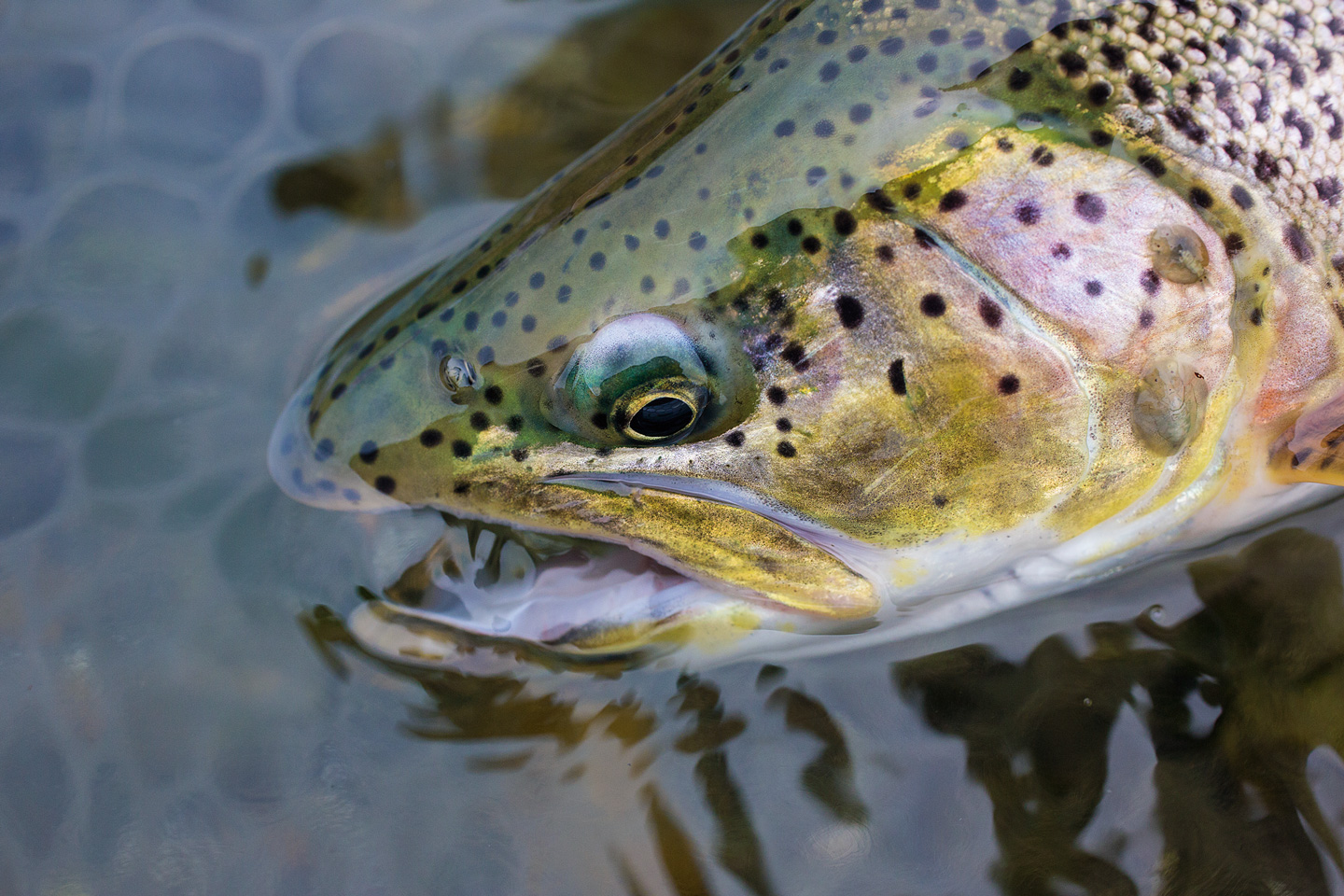
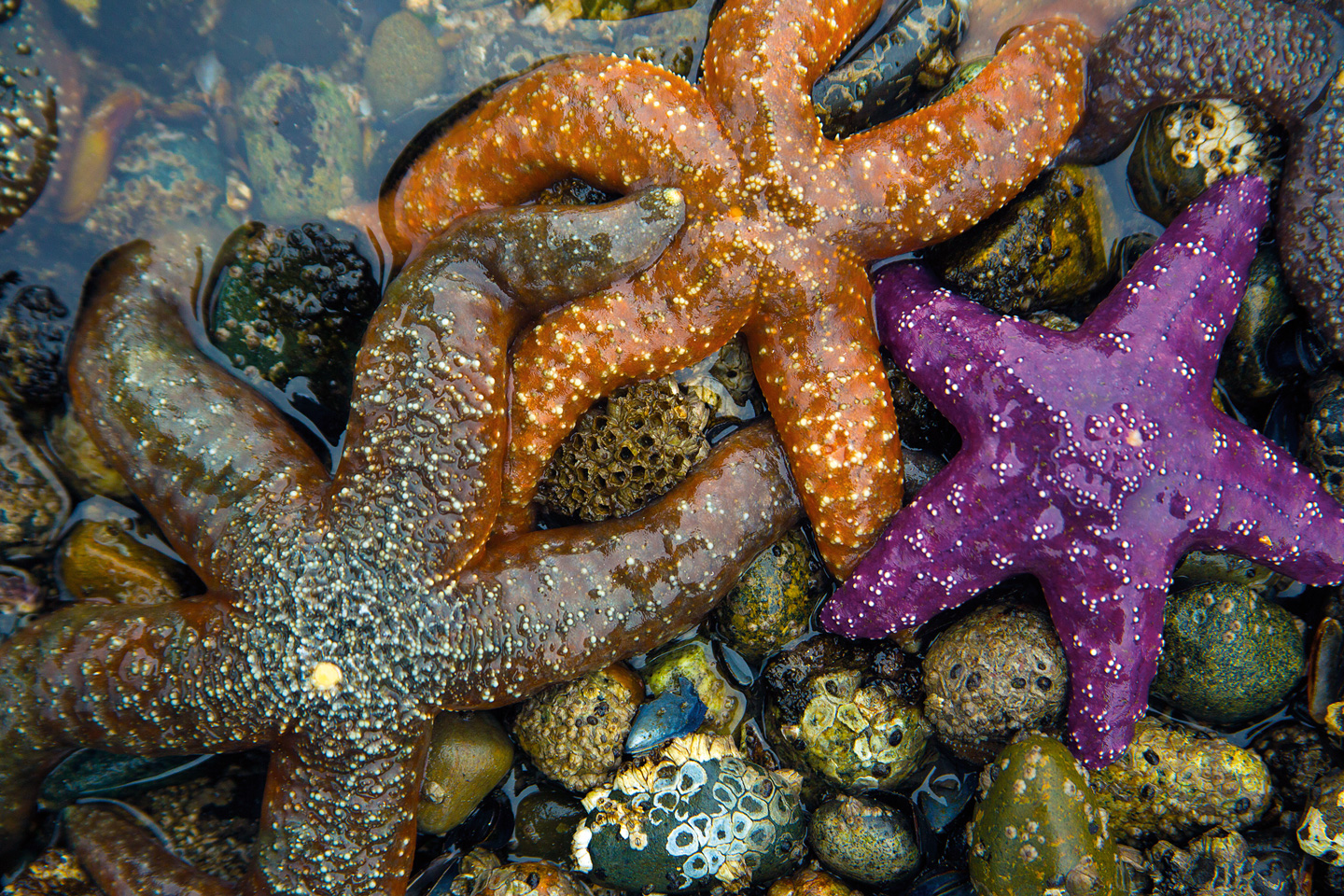
above top to bottom The brilliant colors of a sea-run cutty marred by an unwelcome passenger—sea lice—on the gill plate. These tiny crustaceans attach themselves to fish and primarily feed on blood, mucus and skin. Fish farms can elevate the rate of sea lice infestation in anadromous fish up to 40 miles from their pens. Photo: Dave McCoy
Low tide on the beaches of Puget Sound can be much like living childhood all over again as the receding water unveils the sea’s treasures between casts. Photo: Dave McCoy
The kid draws up in a pitcher’s stance on his paddleboard—a wobbly platform. He leans forward at the hip and puts his hand on his knee, shakes his head a few times like I had somehow signaled him my catcher’s doubts. The wind. The winter-cold water. The tide. The inadequate clothing. No life jackets. The unexpected death of Neil Rollow. The stupidity of youth. The near-complete absence of cutthroat in a place that should have them. The improbable claim of a 16 year old being able to throw a knuckleball. From a paddleboard.
He winds up and I can clearly see the leg rise, the arm gather speed, his leg falls forward and sets, and then the deliberate release, not the break of the wrist but the practiced push of the ball off his fingertips. And now it’s coming at me, with surprising pace. It moves flat through the air, toward my basketball head on this windless, sun-filled April day. Straight as a level. It’s going to hit me between the eyes, I’m sure of it, and part of me says, you should duck now here comes your career-ending subdural.
It moves flat through the air, toward my basketball head on this windless, sun-filled April day. Straight as a level. It’s going to hit me between the eyes, I’m sure of it, and part of me says, you should duck now, here comes your career-ending subdural.
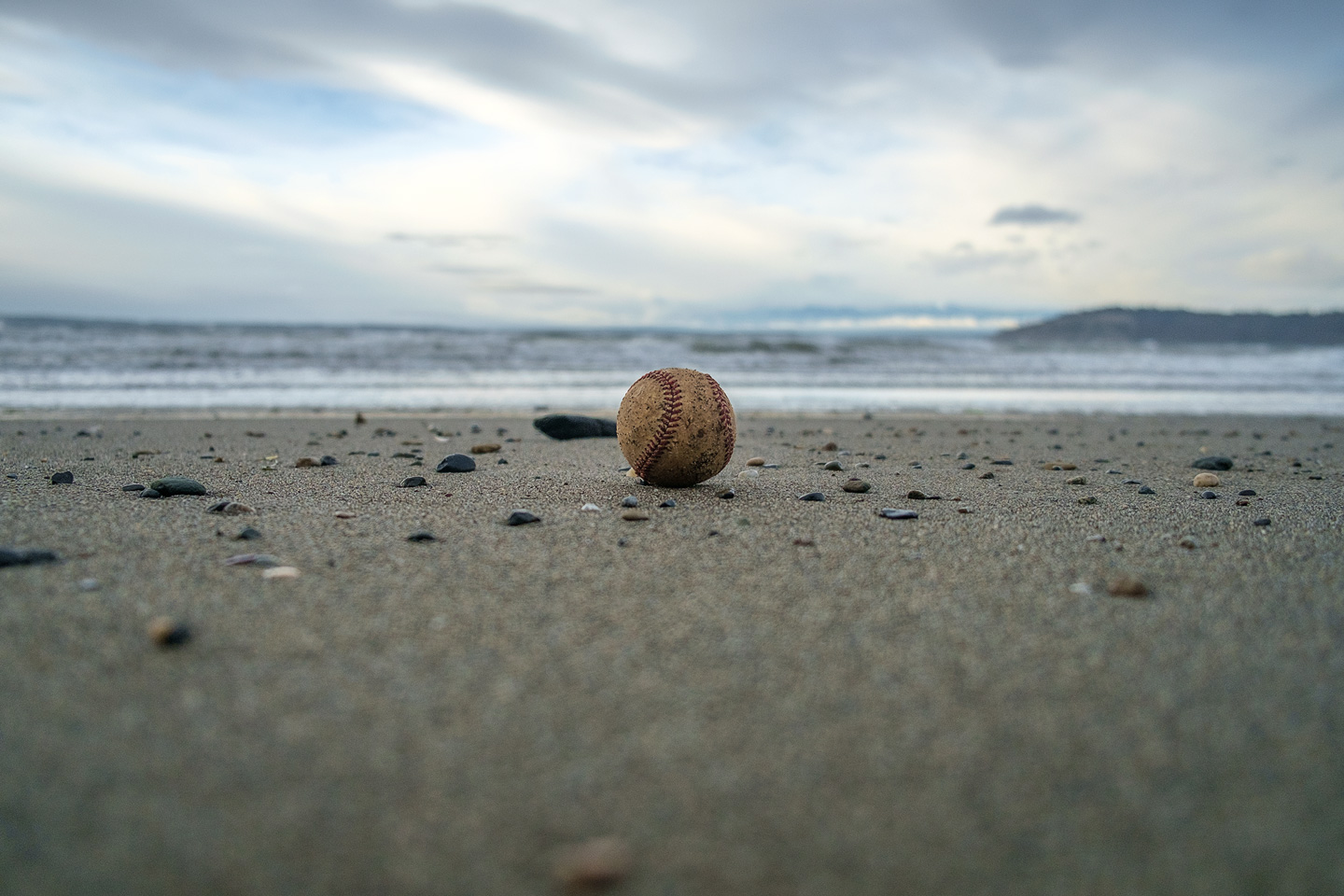
above Time spent on Puget Sound’s beaches means you’re likely to encounter all manner of flotsam and jetsam delivered by the tides, currents and winds. Whether lost or discarded items are deemed treasure or trash depends on who finds them. This treasure was found rolling around on a Whidbey Island, WA beach. Photo: Robert Warren
And then, as if attached to invisible strings and controlled by some ghost puppeteer, the ball flutters and steps, drops a foot, bumps back up six inches, shifts and dances and shoots by, knee-high, through a strike zone and thuds onto the beach behind me. It is spectacular. A true knuckleball thrown by a kid on a paddleboard at a man on a beach. A middle-aged man who pretty much expected failure at minimum, disaster at most. I am stunned.
“Holy crap kid, that was beautiful.”
“Thanks…”
“Do it again? Let’s see some more magic. I’ll throw it back to you.”
There’s no way I can throw a ball to a kid who’s now drifted farther, maybe 70 feet now, and get it in his hands. They know it. I know it. Good Lord, I can’t even hit a garage door from 40 feet, and that was two years ago. So they drift on, the tide pulls them out into the passage, into the deep, black, deadly water and out of earshot. I reel up a little, drop line in my basket, back up onto the beach and find the ball, brush sand off of it, roll it in my hands, try and grasp it like a knuckleballer, toss it up and catch it some, just like the kid had done earlier. It wasn’t waterlogged, the stitches were tight and true, the weight just about what it should be. Apart from the ball’s color, all my assumptions about it were wrong.
That April ball is going on my mantel, in honor of Neil and his boy John. Not a home-run ball from opening day from some overpaid slugger. No sir, a ball from a kid who knew how to throw, a kid who was taught how to pitch by someone who cared, who nagged, who cajoled, who encouraged him to stick with it. I’d call my sister and talk to John P. Rollow, in Arizona, and tell him all about this day, tell him about the kid, about that perfect knuckleball thrown at my head, and ask how his pitching was going, and tell him, most of all, that I missed him.
As I fish on, I talk more to myself, the absorbed ramblings of a fisherman alone—we all do it. It’s the only moment I ever feel like I’m a kid again, narrating a game, bottom of the ninth, bases loaded. Just one more cast. I watch the clouds mass south of the Olympic range, feel the wind pick up a little, and see the kids out far in the passage paddle on, cool and confident, and then they vanish to wherever it was they came from.
This story originally appeared in The Flyfish Journal Volume 8 Issue 3.
